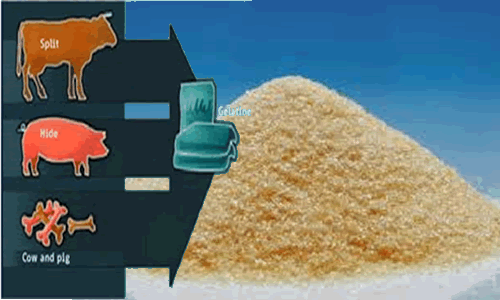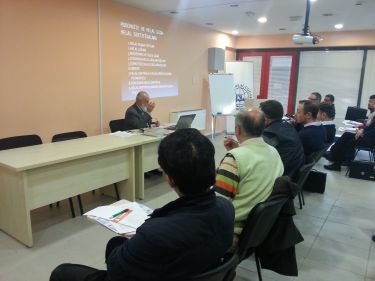By Dr.H.K.BÜYÜKÖZER
Gelatin is a protein produced by partial hydrolysis of collagen extracted from the boiled bones, connective tissues, organs and some intestines of animals such as domesticated cattle, pigs, horses and fish. The natural molecular bonds between individual collagen strands are broken down into a form that rearranges more easily. Gelatin melts to a liquid when heated and solidifies when cooled again. Together with water, it forms a semi-solid colloid gel. Gelatin forms a solution of high viscosity in water, which sets to a gel on cooling, and its chemical composition is, in many respects, closely similar to that of its parent collagen.
Gelatin solutions show viscoelastic flow and streaming birefringence. If gelatin is put into contact with cold water, some of the material dissolves. The solubility of the gelatin is determined by the method of manufacture. Typically, gelatin can be dispersed in a relatively concentrated acid. Such dispersions are stable for 10–15 days with little or no chemical changes and are suitable for coating purposes or for extrusion into a precipitating bath. Gelatin is also soluble in most polar solvents. Gelatin gels exist over only a small temperature range, the upper limit being the melting point of the gel, which depends on gelatin grade and concentration and the lower limit, the freezing point at which ice crystallizes. The mechanical properties are very sensitive to temperature variations, previous thermal history of the gel, and time. The viscosity of the gelatin/water mixture increases with concentration and when kept cool (≈ 4 °C).
Although gelatin is 98-99% protein by dry weight, it has less nutritional value than many other protein sources. Gelatin is unusually high in the non-essentialamino acids glycine and proline (i.e., those produced by the human body), while lacking certain essential amino acids (i.e., those not produced by the human body). It contains no tryptophan and is deficient in isoleucine, threonine, and methionine.
The approximate amino acid composition of gelatin is: Glycine 21%,proline 12%, hydroxyproline 12%, glutamic acid 10%, alanine 9%, arginine 8%, aspartic acid 6%, lysine 4%, serine 4%, leucine 3%, valine 2%, phenylalanine2%, threonine 2%, isoleucine 1%, hydroxylysine 1%, methionine and histidine <1% and tyrosine <0.5%. These values vary, especially the minor constituents, depending on the source of the raw material and processing technique.
Probably best known as a gelling agent in cooking, different types and grades of gelatin are used in a wide range of food and non-food products: Common examples of foods that contain gelatin are gelatin desserts, trifles, aspic, marshmallows, and confectioneries such as Peeps, gummy bears and jelly babies. Gelatin may be used as a stabilizer, thickener, or texturizer in foods such as jams, yoghurt,cream cheese, and margarine; it is used, as well, in fat-reduced foods to simulate the mouthfeel of fat and to create volume without adding calories.
Gelatin is used for the clarification of juices, such as apple juice, and of vinegar.
Gelatin typically constitutes the shells of pharmaceutical capsules in order to make them easier to swallow. Hypromellose is a vegan-acceptable alternative to gelatin, but is more expensive to produce.
Animal glues such as hide glue are essentially unrefined gelatin.
It is used to hold silver halide crystals in an emulsion in virtually all photographic films and photographic papers. Despite some efforts, no suitable substitutes with the stability and low cost of gelatin have been found.
Used as a carrier, coating or separating agent for other substances; for example, it makes beta-carotene water-soluble thus imparting a yellow colour to anysoft drinks containing beta-carotene.
Gelatin is closely related to bone glue and is used as a binder in match heads and sandpaper.
Cosmetics may contain a non-gelling variant of gelatin under the name hydrolyzed collagen.
As a surface sizing, it smooths glossy printing papers or playing cards and maintains the wrinkles in crêpe paper.
Gelatin Substitutes
An alternative source of gelatin substitutes could be natural gel sources such as
• Pectin (obtained from apple) E440A
• Agar Agar (a seaweed)
• Guar Gum E 412
• Modified Starch (plant) E1400-E1450
• Gum Tragacants (plant) E413
• Arabic Gum (plant) E414
• Alginates (Plant) E401-E404
• Carragenaan (plant) E407
There are so many sources of alternate products to E 411 Gelatin, food producers insist on importing Gelatin from Europe, India, USA, Ukraine although Gelatin from these countries are mostly from Haram ingredients and procedures. It looks like they will continue to do so until Muslim consumers awake.
The total production of Gelatin worldwide is 380,000Tons per year, 99 % of which is produced by non-Muslim countries. 200,000Tons of this production is consumed in Muslim countries. As far as we know, Turkey imported 4,000tons of Gelatin last year.
Gelatin in Ice creams and Drinks
Do you know what is more sly and desperate? They use Gelatin in production of Ice creams and juices and concentrates. Gelatin stabilizes beta-carotene, an additive used for coloring agent. In ice creams, Gelatin makes solidifying process faster.
Gelatin Production Process
Considering increasing inquiries from our members and visitors on Gelatin production, we would like to give a brief explanation here. Plants that can process 2,000-3,000tons per year are possible. The most important issue is to establish a fully Halal supply chain of bones and hides to be processed.
Gelatin Production
Gelatin is recovered from collagen by hydrolysis. There are several varieties of gelatin, the composition of which depends on the source of collagen and the hydrolytic treatment used.
The principal raw materials used in gelatin production today are cattle bones, cattle hides, and porkskins. Extraneous substances, such as minerals (in the case of bone), fats and albuminoids (found in skin), are removed by chemical and physical treatment to give purified collagen. These pre-treated materials are then hydrolyzed to gelatin which is soluble in hot water.
Cattle hides are the least used gelatin raw material in North America today. Gelatin recovered from bone is used primarily in photographic applications: some is used for pharmaceutical purposes. The so-called green bone from the slaughter of cattle is cleaned, degreased, dried, sorted, and crushed to a particle size of about 1-2 cm. The pieces of bone are then treated with dilute hydrochloric acid to remove mineral salts. The resulting sponge-like material is called ossein. From this point on in the manufacture of Type B gelatin, both cattle hides and ossein receive similar treatment.
Cattle hides are available from trimming operations in leather production. Cattle hides are usually dehaired chemically with a lime/sulfide solution followed by mechanical loosening.
For the production of Type B gelatin, both ossein and cattle hide pieces are subjected to lengthy treatment with an alkali (usually lime) and water at ambient temperature. Depending on previous treatment, the nature of the material, the size of the pieces, and the exact temperature, liming takes 5-20 weeks, usually 8-12. The process is controlled by the degree of alkalinity of the lime liquor as determined by titration with acid, or by making test extractions.
Ossein usually requires more liming than cattle hides. Additional lime is added to maintain an excess, thereby compensating for any consumed. During liming some deamination of the collagen occurs, with evolution of ammonia. After conditioning, the raw material is thoroughly washed with cold water to remove excess lime; the pH adjusted with acid; and the product extracted with hot water to recover the soluble gelatin.
Porkskin is currently the most significant raw material source for production of edible gelatin in North America. Supplied as either fresh or frozen, porkskins come from slaughter houses and meat processing plants already trimmed of fat, flesh and hair. Porkskins are usually dehaired by scalding with a hot dilute caustic soda solution.
When porkskins are utilized for production of Type A gelatin they are washed with cold water and then soaked in cold dilute mineral acid for several hours until maximum swelling has occurred. Hydrochloric acid and sulfuric acid are most commonly employed. The remaining acid is then drained off and the material is again washed several times with cold water. The porkskins are then ready for extraction with hot water.
The pH, time, temperature, and number of extractions varies from processor to processor depending on product needs, type of equipment employed, time of operations, and economics. Extraction procedures are closely controlled in the manufacture of both type A and type B gelatin since they influence both quality and quantity. Although continuous extraction is used by some processors, most methods still employ discrete batch fractions. Extraction is normally carried out in stainless steel vessels equipped with provisions for heating and temperature control.
The number of extractions varies, 3-6 is typical. The first extraction generally takes place at 50-60-degrees C. The final extraction is carried out close to the boiling point. Extracts are kept separate, analyzed, and subsequently blended to meet various customer specifications.
Earlier extractions have higher molecular weights, higher viscosity, higher gel strength, and the least color. The later extractions are made at increasingly higher temperatures; the resulting product has lower molecular weight, lower gel strength, and greater color.
The dilute gelatin solutions from the various hot water extractions are filtered, deionized, and concentrated by cross-flow membrane filtration and/or vacuum evaporation. The gelatin solution is then chilled and either cut into ribbons or extruded as noodles, and the gelled material is deposited as a bed onto an endless, open weave, stainless steel belt. The belt is passed through a drying chamber, which is divided into zones in each of which the temperature and humidity of the drying air is accurately controlled. Typical temperatures range from about 30-degrees C in the initial zone up to about 70-degrees C in the final zone. The air is usually conditioned by filtration, dehumidification and tempering.
Drying involves progressive increases in air temperature, often with exhaustion of moist air and replenishment with conditioned air. Drying time is 1-5 hours, depending on the quality and concentration of the material and the exact conditions employed. The rate of drying is carefully controlled to avoid melting and case hardening. The gelatin leaves the dryer with a moisture content of about 10%. The dried bed is then broken into pieces that are ground to the required particle size.





